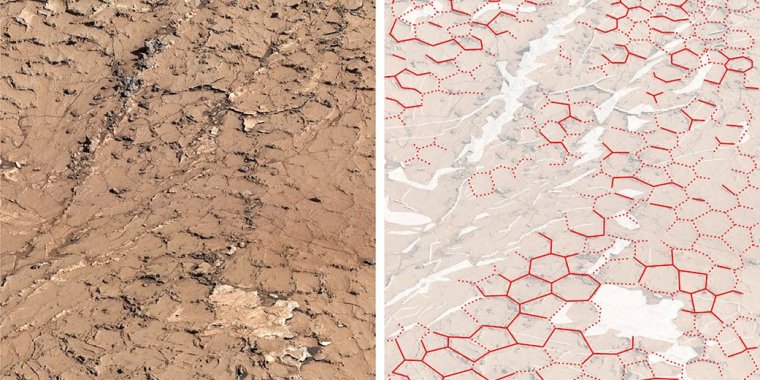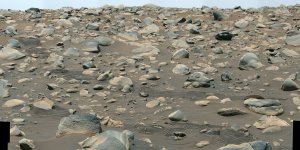| News / Space News |
Cracks in Ancient Martian Mud Surprise NASA’s Curiosity Rover Team
Scientists aren’t entirely sure how life began on Earth, but one prevailing theory posits that persistent cycles of wet and dry conditions on land helped assemble the complex chemical building blocks necessary for microbial life. This is why a patchwork of well-preserved ancient mud cracks found by NASA’s Curiosity Mars rover is so exciting to the mission’s team.

A close-up of the panorama taken by Curiosity’s Mastcam at “Pontours” reveals hexagonal patterns – outlined in red in the same image, right – that suggest these mud cracks formed after many wet-dry cycles occurring over years. Photo: NASA/JPL-Caltech/MSSS/IRAP
“These particular mud cracks form when wet-dry conditions occur repeatedly – perhaps seasonally,” said the paper’s lead author, William Rapin of France’s Institut de Recherche en Astrophysique et Planétologie.
Curiosity is gradually ascending the sedimentary layers of Mount Sharp, which stands 3 miles (5 kilometers) high in Gale Crater.
The rover spotted the mud cracks in 2021 after drilling a sample from a rock target nicknamed “Pontours,” found within a transitional zone between a clay-rich layer and one higher up that is enriched with salty minerals called sulfates.
While clay minerals usually form in water, sulfates tend to form as water dries up.
The minerals prevalent in each area reflect different eras in Gale Crater’s history. The transitional zone between them offers a record of a period when long dry spells became prevalent and the lakes and rivers that once filled the crater began to recede.
As mud dries out, it shrinks and fractures into T-shaped junctions – which are what Curiosity discovered previously at “Old Soaker,” a collection of mud cracks lower down on Mount Sharp.
Those junctions are evidence that Old Soaker’s mud formed and dried out once, while the recurring exposures to water that created the Pontours mud caused the T-shaped junctions to soften and become Y-shaped, eventually forming a hexagonal pattern.
The hexagonal cracks in the transitional zone kept forming even as new sediment was deposited, indicating that the wet-dry conditions continued over long periods of time.
ChemCam, Curiosity’s precision laser instrument, confirmed a hardy crust of sulfates along the cracks’ edges, which isn’t too surprising given the proximity of the sulfate region. The salty crust is what made the mud cracks resistant to erosion, preserving them for billions of years.
YOU MAY ALSO LIKE





